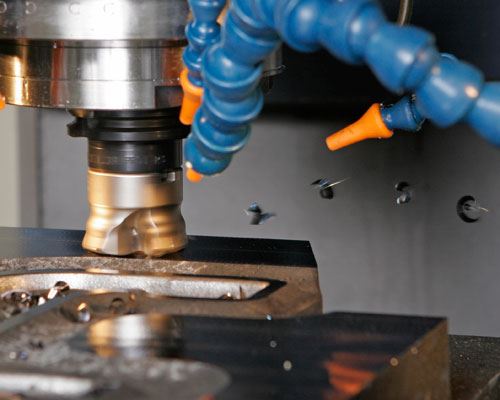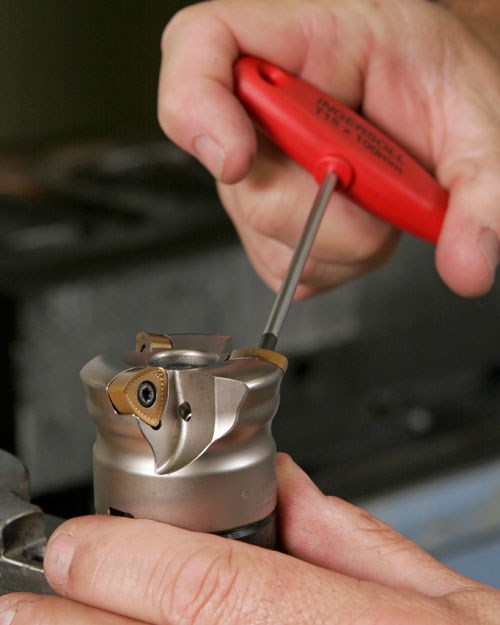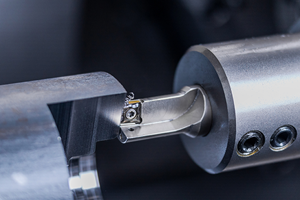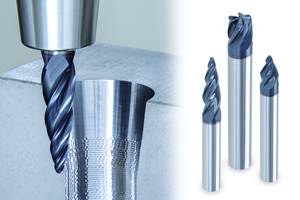Cutter Enables Hard-Part Milling On Light-Duty VMC
SPX relies on its small die shop to provide the tools needed to manufacture its service, testing and maintenance equipment for automotive and agricultural dealerships. With a limited number of machines, the die shop had no choice but to use a light-duty VMC on a process for which it is ill-suited—cutting hardened steel. To avoid jeopardizing the machine’s ceramic spindle bearings and other components, the shop implemented a face mill from Ingersoll Cutting Tools that enabled higher feeds and speeds while reducing cutting forces and spindle load.
Face milling hardened steel on a low-power machine can be a "no-win" situation—and the machine may be the biggest loser of all. Spindle stalling aside, the frames and spindle bearings on many low-power machines simply aren’t built for the extreme cutting forces and hammering—that is, severe vibration—resulting from the interrupted cuts inherent in the milling process.
Cory Pleschourt, diemaker at SPX (Owatonna, Minnesota), solved this problem by retooling one punishing face-milling operation with an Power-Feed+mill from cutting tool manufacturer Ingersoll, then cranking up feeds and speeds. In addition to increasing metal removal rates by 10 percent, this remedy eased cutting forces—especially impact forces—on the machine while reducing spindle load by at least 15 percent. Even at higher feeds and speeds, the hammering that used to plague the operation is largely a thing of the past.
Operating 20 hours a day, 5 days a week, the die shop supplies SPX’s 600-employee main plant with the tools it needs to keep running. It makes and repairs forging dies used to produce service, testing and maintenance equipment for automotive and agricultural dealerships. As a small operation, the die shop has limited machines and limited backup capability—it is "the very definition of ‘lean,’" Mr. Pleschourt says. "We need to get the dies out on schedule, but we can’t afford to jeopardize the few CNC machines we have."
One of the shop’s mainstay machines is a 40-taper VMC with a 14,000-rpm spindle equipped with ceramic bearings. While this machine is well-suited for fine work on die cavities when the die steel is still in the wrought condition, it runs into problems on heavy face-milling operations required to repair Finkl forging die stock that is hardened to Rc 43.
When a worn die arrives, Mr. Pleschourt typically skins off about 3/8 inch from both mating die faces in order to leave enough stock for resinking. Previously, standard practice was to run a 2 1/2 –inch, 4-flute, positive-rake facemill at 600 rpm, 50 ipm and a 0.03-inch cutting depth. Cutting 3/8 inch off a 12- by 8-inch die block took about 15 passes, each of which was 1.8 inches wide. Even at that low feed rate, hammering often caused further slowdowns. "We’re always concerned about the ceramic bearings at the first sign of hammering," Mr. Pleschourt says.
Seeking to better protect the machine during this operation, Mr. Pleschourt asked Ingersoll field engineer Ondrej Lubinski for help. Noting that the machine spindle was rated at 14,000 rpm, Mr. Lubinski suggested Ingersoll’s three-flute Power-Feed+mill face mill along with ramped up feeds and speeds. After testing, the two settled on 1,000 rpm, 100 ipm and a 0.02-inch depth of cut. Despite the increase in feeds and speeds, cutting action was smoother with no hammering, and the spindle power gage read 55 percent, or 15 percent lower than the previous reading.
Mr. Lubinski says feeding faster and cutting shallower works because modern carbide inserts are durable enough to withstand the added wear involved in repetitive, fast passes. "In other words, you punish the cutting edge in order to protect the machine frame, motor and bearings," he explains.
The Power-Feed+face mill is equipped with a negative axial rake and three flutes, whereas the shop’s previous tool had four flutes. At first glance, this may seem to be a formula for rough cutting action on the hardened steel used for the shop’s forging dies. Finding success in such operations, however, is simply a matter of juggling settings to take advantage of the cutter’s geometry, Mr. Lubinski says.
Combined with a shallower cut, ramping up feeds and speeds led to 10 percent faster volumetric metal removal with a 20 percent lower chip load per tooth. "A high-feed cutter in a high speed spindle gives you that option," he explains. Moreover, a negative axial rake helps keep the cutter on track and deter insert pullout or digging into the work. The face mill is also stubbier than the shop’s previous tool, protecting the ceramic spindle bearings against excess lateral forces.
The reduced flute count also protects the low-power machine against stalling in the midst of a heavy cut in hardened steel. That’s because with more edges in the cut, the machine’s motor has to overcome more friction, Mr. Lubinski says. Using only three flutes ensures that more of the machine’s limited horsepower goes toward cutting, where it is needed the most. Additionally, the face mill’s negative axial rake enables the cutter to employ two-sided, triangular inserts. Thus, the shop can buy half as many inserts as before with the same edge life, leading to significant tool cost savings.
"Originally, I simply asked (Mr. Lubinski) how to better protect a light but indispensable machine," Mr. Pleschourt says. "We gained that extra safety margin plus faster throughput on a recurring operation."
Related Content
How to Tackle Tough Angled Pocket Milling With Two Tools
Milling a deep pocket with a tight corner radius comes with unique challenges, but using both a flat bottom drill and a necked-down finishing tool can help.
Read MoreAll-Around Mill Improves Productivity and Cost for Valve Job
Adopting a mill with a double-negative rake and pockets compatible with multiple insert geometries enabled Progressive Metal Service to increase feed and lower scrap rates for a valve.
Read MoreCeratizit's Updated Tooling Solutions Improve Machining Performance
The company has upgraded its EcoCut indexable inserts lineup, as well as introduced two new toolholding and workholding solutions.
Read MoreTungaloy Expands Line of Barrel-Shaped End Mills
The new SolidMeister barrel end mills are efficient tools for complex 3D-surfacing operations used in mold making, orthopedic implants and the machining of other freeform surfaces.
Read MoreRead Next
The Cut Scene: The Finer Details of Large-Format Machining
Small details and features can have an outsized impact on large parts, such as Barbco’s collapsible utility drill head.
Read More3 Mistakes That Cause CNC Programs to Fail
Despite enhancements to manufacturing technology, there are still issues today that can cause programs to fail. These failures can cause lost time, scrapped parts, damaged machines and even injured operators.
Read More










.png;maxWidth=300;quality=90)









.png;maxWidth=300;quality=90)







